| Home -> Other California History Books -> Information for Visitors to the Panama-Pacific International Exposition - San Francisco - 1915 - Text | |||||||||||||||||||||||||||||||||||||||||||||||||||||||||||||||||||||||||||||||||||||||||||||||||||||||||||||||||||||||||||||||||||||||||||||||||||||||||||||||||||||||||||||||||||||||
 |
|||||||||||||||||||||||||||||||||||||||||||||||||||||||||||||||||||||||||||||||||||||||||||||||||||||||||||||||||||||||||||||||||||||||||||||||||||||||||||||||||||||||||||||||||||||||
 Illuminated Perspective Showing novel scheme of throwing colored rays from powerful search lights anchored in bay. Copyright 1913 by the P.P.I.E. Co. |
|||||||||||||||||||||||||||||||||||||||||||||||||||||||||||||||||||||||||||||||||||||||||||||||||||||||||||||||||||||||||||||||||||||||||||||||||||||||||||||||||||||||||||||||||||||||
|
|
|||||||||||||||||||||||||||||||||||||||||||||||||||||||||||||||||||||||||||||||||||||||||||||||||||||||||||||||||||||||||||||||||||||||||||||||||||||||||||||||||||||||||||||||||||||||
|
Information for Visitors to the
Panama-Pacific International Exposition San Francisco, 1915 An Analysis of the Plan and Scope of the Exposition. Issued January 1, 1914 With Compliments of Kirchner & Mante, Bottlers of Rainier Beer Pictures Copyrighted 1913 by Panama-Pacific International Exposition Co. |
|||||||||||||||||||||||||||||||||||||||||||||||||||||||||||||||||||||||||||||||||||||||||||||||||||||||||||||||||||||||||||||||||||||||||||||||||||||||||||||||||||||||||||||||||||||||
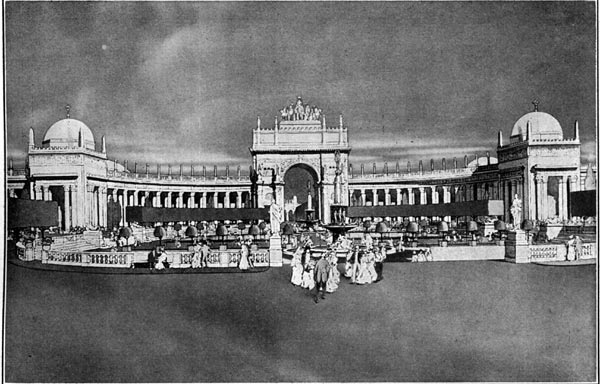 Section of Court of Sun and Stars In its center the court will contain a sunken garden, and in its northern axis, between the Agricultural and Transportation Buildings will be a great pool of water embellished with statuary and fountains and bordered by tropical growth. Copyright 1913 by the P.P.I.E. Co. |
|||||||||||||||||||||||||||||||||||||||||||||||||||||||||||||||||||||||||||||||||||||||||||||||||||||||||||||||||||||||||||||||||||||||||||||||||||||||||||||||||||||||||||||||||||||||
 In the roll call of the centuries, the year 1915 will loom with epochal greatness, for from winter to winter, there will be held in San Francisco a magnificent celebration of the most wonderful achievement of man. The Panama-Pacific International Exposition, itself an achievement of overwhelming grandeur, will celebrate the completion of the Panama Canal - man's most audacious correction of Nature's work and his greatest triumph over unfriendly forces. The celebration will be worthy the event it commemorates, and both go down in history as a world's gift to the nations from their youthful, stalwart brother in peace, the United States of America. The physical mingling of the waters of the Atlantic with the waters of the Pacific will find its corollary in the mingling in San Francisco of the peoples from all lands whose shores are washed by those waters, or whose rivers find their resting place there. In the roll call of the centuries, the year 1915 will loom with epochal greatness, for from winter to winter, there will be held in San Francisco a magnificent celebration of the most wonderful achievement of man. The Panama-Pacific International Exposition, itself an achievement of overwhelming grandeur, will celebrate the completion of the Panama Canal - man's most audacious correction of Nature's work and his greatest triumph over unfriendly forces. The celebration will be worthy the event it commemorates, and both go down in history as a world's gift to the nations from their youthful, stalwart brother in peace, the United States of America. The physical mingling of the waters of the Atlantic with the waters of the Pacific will find its corollary in the mingling in San Francisco of the peoples from all lands whose shores are washed by those waters, or whose rivers find their resting place there.From February 20, 1915, until December 4, 1915, the multitudes of the earth will gather in San Francisco to contribute in a national, communal, and individual capacity, to the celebration which San Francisco has proposed and engineered with the valiant assistance of her mother, California, her sister states and her related nations of the world. Location. - Fronting San Francisco Bay, which here sweeps majestically towards the Golden Gate, and with an average width of half a mile, the 635 acres which constitute the Exposition area, are located in a natural amphitheatre, sloping from south to north to the bay shore. To the south rise the peopled hills of San Francisco, while to the southwest are the forest covered ridges in which the guns of the Presidio lie hid in friendly silence. The arrangement of the building scheme forms a triptych, the three elements of which, while distinct in detail, will blend in an harmonious whole. Approached from the bay, the visitor will behold to the east the buildings of the Amusement Concessions, which will cover 65 acres; the westward gaze will embrace the Foreign Nations' pavilions and the buildings erected by the various states of the Union. These will cover an area of 92 acres. Centering this vast scheme of landscape and architectural beauty, the eleven beautiful Main Exhibit Palaces, which will occupy 218 acres, are now arising. The rest of the area of the Exposition grounds will be devoted to scenic beauty as expressed in broad lawns of tree-shaded green, artificial lakes, mirroring trees and architectural piles, statuary from the world's masters, gardens bright with perennially blooming flowers, and parked areas restful to the eye and skirted by broad avenues or traversed by picturesque paths. At the extreme western end and adjacent to the United States Military Reservation of the Presidio, will be located the aviation grounds, race track, and the live stock exhibits. In planning the area of the present Exposition, a careful study was made of the experience of previous enterprises of this character. The exposition area at Philadelphia was found to be large enough for its purpose, that at Chicago increased the acreage, and that at St. Louis, in still further extending the borders of her exposition grounds beyond the measure of Chicago and Philadelphia's land space, had embarrassed herself with an unwieldy domain. These were significant facts for the guidance of San Francisco's experts. The result of the consideration given the vital question of area will be evident in the arrangement of the exhibit buildings and the policy which will be pursued in dealing with the exhibits themselves. The Exhibit Palaces are grouped around a splendid central court, the grandeur of which is suggested in the title chosen for it - the Court of the Universe. Communication between these palaces is effected by a series of courts, each one a triumph of architectural beauty. There are five, of these courts, and they are designated as the Court of the Universe, already mentioned; the Court of the Four Seasons, the Court of Palms, the Court of Flowers, and the Court of Abundance. These courts, with their extensions, pierce the central quadrangle of the Exhibit Palace area, and communicate with the Esplanade of the Marina, which skirts the Exposition grounds along the bay shore, and with the Alameda, which is the southern garden of the grounds and will be a semi-tropical paradise. These gardens will permit an unobstructed perspective of the entire group of palaces in all of their grandeur, both from the bay and from the southern entrance gates, and the entire scheme will present the easiest, shortest and most inviting method of intercommunication which it is possible to devise. |
|||||||||||||||||||||||||||||||||||||||||||||||||||||||||||||||||||||||||||||||||||||||||||||||||||||||||||||||||||||||||||||||||||||||||||||||||||||||||||||||||||||||||||||||||||||||
 Court of Palms One of the superb Italian Towers that will mark the approach to Court of Palms. Copyright 1913 by the P.P.I.E. Co. |
|||||||||||||||||||||||||||||||||||||||||||||||||||||||||||||||||||||||||||||||||||||||||||||||||||||||||||||||||||||||||||||||||||||||||||||||||||||||||||||||||||||||||||||||||||||||
| Completion of the Buildings. - At this time, a year in advance of the opening date, all of the exhibit palaces are so well under way that they will be completed fully eight months before the day when the gates are thrown open. Ample time is thus afforded for the growth of the trees, shrubs, and vines which are now being transplanted on Exposition soil, and for the installation of exhibits. The industry and diligence shown in the construction of the buildings has the effect of stimulating the entire work and the fact that the progress is farther advanced in this Exposition than has ever been the case at a similarly distant date from the opening of any other exposition is assurance that President Charles C. Moore's promise concerning the readiness of the Exposition will be kept with certainty and ease. Palaces and Exhibits. - The vision of the Exposition is directed forward, not backward. This will be a contemporaneous display, rather than an historic one. The progress of the world during the decade preceding 1915 will be shown, and no exhibit will be reviewed for award which antedates that period in its creation. The exhibits have been grouped in eleven departments, as follows: Department A, Fine Arts Department B, Education Department C, Social Economy Department D, Liberal Arts Department E, Manufactures and Varied Industries Department F, Machinery Department G, Transportation Department H, Agriculture Department I, Live Stock Department K, Horticulture Department L, Mines and Metallurgy Each to be housed in a palace of the same name. Notwithstanding the fact that the floor area of these Exposition palaces will be far greater than that of any previous exposition, the entire exhibit space has, at this date, January 1, 1914, been 25 per cent oversubscribed, a condition unknown at previous expositions, and it is estimated that before the completion of these palaces the application for space in them will be double that available. This condition permits the assurance of a choice selection of exhibits. |
|||||||||||||||||||||||||||||||||||||||||||||||||||||||||||||||||||||||||||||||||||||||||||||||||||||||||||||||||||||||||||||||||||||||||||||||||||||||||||||||||||||||||||||||||||||||
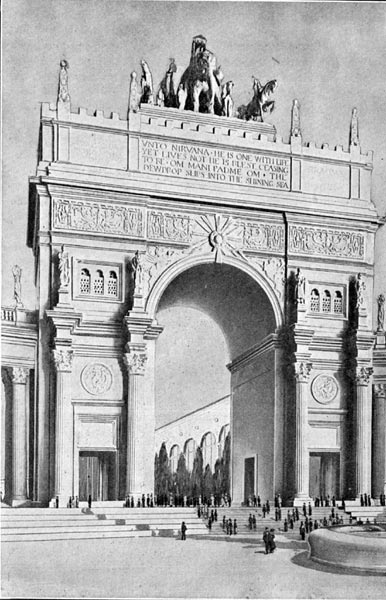 Arch of the Rising Sun, Court of the Sun and Stars One of the most beautiful of the great inner courts. Copyright 1913 by the P.P.I.E. Co. |
|||||||||||||||||||||||||||||||||||||||||||||||||||||||||||||||||||||||||||||||||||||||||||||||||||||||||||||||||||||||||||||||||||||||||||||||||||||||||||||||||||||||||||||||||||||||
| Palace of Machinery. - The Palace of Machinery is completed. It is the largest building on the Exposition site, and the largest wooden structure in the world. If set end to end, the ornamental cornices of this huge building would extend a mile and a half; bolts and washers weighing 1500 tons have been used and four carloads of nails have been employed in fastening in place 8,000,000 feet of lumber used in its construction. The multitude of improvements that have been invented and applied in machinery during the last few years will make the exhibit in this building the most interesting in mechanical history and in no department of the Palace of Machinery will there be more novelty disclosed than in the engines that are operated by crude oil without the agency of a boiler. Palace of Fine Arts. - Befitting the incalculable value of its contents, the Palace of Fine Arts will be a fireproof structure, and it will also be an architectural classic. Its length from north to south will be 600 feet, and on the placid waters of an artificial lake will be mirrored its Grecian beauty. Palace of Horticulture. - If the Palace of Machinery is the largest wooden structure in the world, the Palace of Horticulture will probably be the largest glass building. It will cover five acres, and will be surmounted by a dome 185 feet in height. Its length will be 625 feet and its greatest width, 320 feet. An imposing nave will run the length of the building. Palace of Transportation. - In these days, when zeal for speed, impatience at delay, and necessity for haste are active principles of life, the problems and products of transportation assume universal importance. The Palace of Transportation will house exhibits from all of the great steamship and railway companies. The water navigation of all countries, characteristic boats of various nations, yachts, sail and steam, motor boats and the like will be seen in all their manifold varieties, either in model or working exhibits. From the latest type of monster mountain climbing locomotive to soaring aeroplane, latest developments in street car vehicles, electric conveyances and all kinds of appliances and equipment to render less hazardous the traffic of the world, will be shown, and in the realm of aviation, working, actual models, flights and daring dips in mid air will thrill and instruct. |
|||||||||||||||||||||||||||||||||||||||||||||||||||||||||||||||||||||||||||||||||||||||||||||||||||||||||||||||||||||||||||||||||||||||||||||||||||||||||||||||||||||||||||||||||||||||
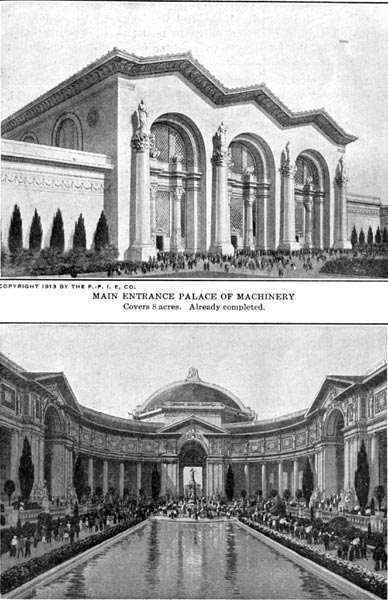 Top - Main Entrance Palace of Machinery Covers 8 acres. Already completed. Copyright 1913 by the P.P.I.E. Co. Bottom - Part of Court of Palms Copyright 1913 by the P.P.I.E. Co. |
|||||||||||||||||||||||||||||||||||||||||||||||||||||||||||||||||||||||||||||||||||||||||||||||||||||||||||||||||||||||||||||||||||||||||||||||||||||||||||||||||||||||||||||||||||||||
|
Palace of Education. - Primarily this Exposition is to be educational, in the larger meaning of that inclusive term. In the Palace of Education will be displayed in a comprehensive exhibit, educational methods, processes, results, ideal buildings (in model), exploitation of school hygiene, and work done from the kindergarten to higher education, in all branches of vocational, classical and practical learning, and for all classes of students, including even the "subnormal" and the deficient.
Social Economy. - For the first time in the history of expositions, the vital subject of social economy will be given adequate treatment, and the exhibits will embrace work done along lines of Industrial problems, Hygiene, Insurance, Housing, Charities and Corrections, Municipal Organizations and Activities, and many other kindred topics. This department will be housed in the south wing of the Palace of Education. Palace of Agriculture. - In this building will be shown all products of use to mankind that spring from the soil; all manner of modern agricultural implements, machinery and methods of cultivation, harvesting, irrigating, draining, etc., etc. Palace of Food Products. - A separate building for Food Products is for the first time at an exposition to be given a place. Important features of this exhibit will be the Meat and Fish foods that will be shown, and the extent of the display may be realized through the circumstance that everything edible and drinkable which comes for man's benefit and enjoyment, however remotely, from the soil, including all by-products and manufactured forms thereof, will be housed with this most significant exhibit. |
|||||||||||||||||||||||||||||||||||||||||||||||||||||||||||||||||||||||||||||||||||||||||||||||||||||||||||||||||||||||||||||||||||||||||||||||||||||||||||||||||||||||||||||||||||||||
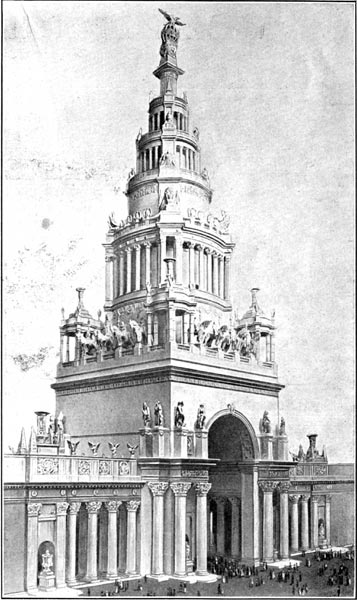 Tower of Jewels, Height 426 Feet Covers one acre in ground area. Forms the entrance to the grand central "Court of the Sun and Stars." Copyright 1913 by the P.P.I.E. Co. |
|||||||||||||||||||||||||||||||||||||||||||||||||||||||||||||||||||||||||||||||||||||||||||||||||||||||||||||||||||||||||||||||||||||||||||||||||||||||||||||||||||||||||||||||||||||||
 |
|||||||||||||||||||||||||||||||||||||||||||||||||||||||||||||||||||||||||||||||||||||||||||||||||||||||||||||||||||||||||||||||||||||||||||||||||||||||||||||||||||||||||||||||||||||||
| Palace of Liberal Arts. - Applying the science of art and man in mechanical processes of innumerable kinds, the Department of Liberal Arts is evolved, reflecting man's education and culture, mirroring his tastes and inspiring them at the same time, demonstrating his inventive genius, his attainments in the science and embodying them in artistic creations. The Palace of Liberal Arts will be one of the most artistic as well as one of the most prominent and popular features on the Exposition grounds. It will occupy a position directly opposite the main entrance. Covering an area of nearly six acres, it is 585 feet long and 475 feet wide. Palace of Mines and Metallurgy. - Within the Palace of Mines and Metallurgy will be displayed the mineral products of the world, together with illustrations of mining and metallurgical processes. Especial attention will be given the new and rarer minerals and the processes for their reduction. These include the several ores, which have lately come into prominence on account of their radio-active properties. Palaces of Manufactures and Varied Industries. - The department of the Exposition, which visitors are most certain to appreciate, is the exhibition of finished products of manufacture and manual skill, and so comprehensive will be this collection of exhibits that two colossal buildings will be required to house them. Live Stock. - Conforming to the general plans of the Exposition, the Department of Live Stock will be maintained on a scale hitherto unknown to expositions. For the first time, too, the exhibit of Live Stock will be continual from the opening until the closing day, so that lovers of horses, dogs, household pets of all kinds, breeders of cattle, and students of Live Stock in its various phases, may witness the exhibit, which will be gathered from the farthest lands as well as from the plains of home. International cavalry and polo contests and harness races are some of the special events that are scheduled and prizes of large sums in money as well as trophies will be awarded. |
|||||||||||||||||||||||||||||||||||||||||||||||||||||||||||||||||||||||||||||||||||||||||||||||||||||||||||||||||||||||||||||||||||||||||||||||||||||||||||||||||||||||||||||||||||||||
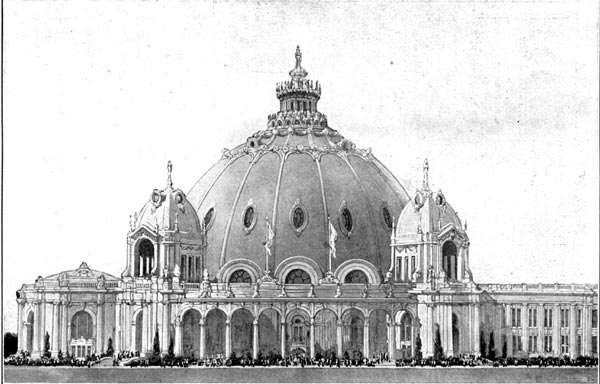 Festival Hall Contains a huge pipe organ and is adapted to conventions, congresses and musical gatherings. Copyright 1913 by the P.P.I.E. Co. |
|||||||||||||||||||||||||||||||||||||||||||||||||||||||||||||||||||||||||||||||||||||||||||||||||||||||||||||||||||||||||||||||||||||||||||||||||||||||||||||||||||||||||||||||||||||||
| Naval Features. - The location of the Exposition grounds is ideal for both military and naval displays, and in the nature of the Exposition's celebration, it is fitting that the navies of the world should assemble in the bay whose blue waters ripple against the parked northern edge of the Marina. Four years prior to the opening of the Exposition; on March 4, 1911, a bill was passed by Congress asking the President to invite all maritime nations to send their fleets to Hampton Roads in 1915, there to be reviewed by the President before proceeding via the Panama Canal to San Francisco. It is expected that this naval pageant will be one of the most impressive and spectacular events of the Exposition. Music. - The greatest military bands in the world will assemble at the Exposition to provide spirited music. An Exposition Orchestra of instrumentalists of fame, concerts by the leading organizations of this country and Canada, organ recitals by the best artists from all music centers and the inspiring Welsh Eisteddfod are a few of the musical attractions that will be offered to the visitor. Street of Amusements. - The Exposition will undertake to amuse as well as instruct and promises to eclipse in merriment the pleasures afforded on "The Midway" at Chicago, or "The Pike" at St. Louis. On the main amusement street, 3,000 feet long, will be located every device that can amuse, entertain, or thrill the patron. The most ingenious minds are busy at their imaginative work to make this amusement thoroughfare an hilarious road of unique diversion. More than 7,000 applications for concession space have already been filed, and of these less than a hundred have been granted, and these only after their respective high qualities of novelty and interest were established. A total sum of $12,000,000 will be invested in these concessions by their operators, and an army of more than 7,000 will be employed to maintain them. A few among the accepted concessions are: The Grand Canyon, a splendid spectacle to be installed by the Santa Fe Railroad; The Panama Canal, a monster working model of the canal; Submarines under Water; "Yellowstone Park;" "The Grand Trianon of Napoleon;" "Creation," from the First Chapter of Genesis; Frederic Thompson's "Toyland;" "Nuremberg;" "The Fall of Adrianoplc;" an "Ice Palace," in which iceskating and hockey matches will be held; an, Oriental Village; "Forty-nine Camp;" "The Battle of Gettysburg;" "Mohammed's Mountain;" "Aeroscope;" "Chinese City;" a submarine restaurant; Hagenback's wild animals, etc., etc. Participation. - The following foreign countries had, January 1, 1914, accepted the nation's invitation to participate in the Exposition: |
|||||||||||||||||||||||||||||||||||||||||||||||||||||||||||||||||||||||||||||||||||||||||||||||||||||||||||||||||||||||||||||||||||||||||||||||||||||||||||||||||||||||||||||||||||||||
|
|||||||||||||||||||||||||||||||||||||||||||||||||||||||||||||||||||||||||||||||||||||||||||||||||||||||||||||||||||||||||||||||||||||||||||||||||||||||||||||||||||||||||||||||||||||||
| Those designated by an * have dedicated their sites up to and including December 1, 1913. Following is a list of the states and dependencies of the United States which have accepted invitation to participate, together with dates of dedication and amount appropriated, up to and including January 1, 1914: |
|||||||||||||||||||||||||||||||||||||||||||||||||||||||||||||||||||||||||||||||||||||||||||||||||||||||||||||||||||||||||||||||||||||||||||||||||||||||||||||||||||||||||||||||||||||||
|
|||||||||||||||||||||||||||||||||||||||||||||||||||||||||||||||||||||||||||||||||||||||||||||||||||||||||||||||||||||||||||||||||||||||||||||||||||||||||||||||||||||||||||||||||||||||
| Congresses and Conventions. - The thinkers and doers of the whole wide world will assemble their conventions and congresses in San Francisco during the Exposition year. According to the data now in the Bureau of Conventions and Societies, 204 congresses and conventions will meet with a delegate strength of from a few hundred to 50,000 members each, and it is expected to add considerably to this number of conventions. Free Convention Hall. - A great auditorium to cost $1,000,000 is now well advanced in construction on the San Francisco Civic Center site and here the conventions may gather, free of charge, under the Exposition auspices. The hall will seat 10,000 and will be the center of many smaller halls and rooms seating from 400 to 1,200 each. It is believed that for the purposes for which it is intended - convention assembly - it will be the most completely appointed and most perfectly arranged structure in America. This main auditorium is situated about a mile from the Exposition grounds, but there will also be convention halls available for those who desire such accommodation within the walls of the Exposition, among others, Festival Hall. Hotel Accommodations. - San Francisco's reputation as a city of hotels and restaurants will be sustained during Exposition year. According to the Chamber of Commerce Records there are in San Francisco 2,023 hotels, apartment and rooming houses, and this number is constantly augmented. More than 90% of the hotels are new, San Francisco being essentially a rebuilt city since the devastating fire of 1906, and the hotels are thus of the most modern type with every room provided with hot and cold water, steam heat, electric lights and telephone. New York is the only American city with greater accommodations for conventions and visitors. Within half an hour's ride from San Francisco by ferry and electric car are the cities of Oakland, Alameda, and Berkeley, where accommodations for fully 50,000 visitors could be found. The Exposition will organize a hotel bureau which will undertake to place visitors with minimum of annoyance. Inside Inn. - For the further convenience of delegates to conventions, there will be erected on the Exposition grounds an intra-mural hotel, which will be called the Inside Inn, and will be provided with large and small halls, with seating capacity of from 100 to 1,000. Transportation. - Traversing the grounds and permitting access to any section will be motor omnibuses and a double track miniature railway, both of which will establish a ten-cent fare; and a transportation novelty, the electric jinriksha, will be available for visitors. Push chairs and tricycle chairs also will be provided. Seeing the Exposition. - The Exposition may be reached by ferry from the foot of Market street (fare. ten cents), or by street cars from any part of San Francisco (fare five cents) and by motor bus. A new ferry service will be established, which will take passengers direct from transbay points to the ferry slip at the Exposition grounds. Single admissions to the Exposition will be sold for 50 cents to all more than twelve years of age; for children between five and twelve, 25 cents will be charged, and children less than five, when accompanied by an adult, will be admitted free. The main exhibit palaces will be opened at 9 o'clock and closed at sundown. No entrance fee will be charged at any exhibit palace. The amusement district will be open until 11 P. M. |
|||||||||||||||||||||||||||||||||||||||||||||||||||||||||||||||||||||||||||||||||||||||||||||||||||||||||||||||||||||||||||||||||||||||||||||||||||||||||||||||||||||||||||||||||||||||
 Top - Lagoon and Palace of Fine Arts Classic in the simplicity of its architecture, unequaled in the charm of its surroundings. Copyright 1913 by the P.P.I.E. Co. Bottom - Palace of Horticulture Covering Five Acres Will afford unrivaled opportunities for the study of fruits, plants, shrubs, flowers and bulbs. Copyright 1913 by the P.P.I.E. Co. |
|||||||||||||||||||||||||||||||||||||||||||||||||||||||||||||||||||||||||||||||||||||||||||||||||||||||||||||||||||||||||||||||||||||||||||||||||||||||||||||||||||||||||||||||||||||||
| Lunches and Other Meals. - A chain of lunch counters, restaurants and cafes will provide meals in every section of the grounds, and in any class of service from a ten-cent sandwich to a course dinner. Menus. - Each restaurant concessionaire will be under contract with the Exposition to provide food at prices agreed upon in the contract. They will cater to all tastes and will range from restaurants providing simple, inexpensive meals to high class cafes ranking with the best in New York or San Francisco. Two of the restaurants will serve 50-cent dinners; others will serve a la carte. The following menu, selected from one of the concessionaires, is typical of what may be procured for visitors of moderate means: |
|||||||||||||||||||||||||||||||||||||||||||||||||||||||||||||||||||||||||||||||||||||||||||||||||||||||||||||||||||||||||||||||||||||||||||||||||||||||||||||||||||||||||||||||||||||||
|
|||||||||||||||||||||||||||||||||||||||||||||||||||||||||||||||||||||||||||||||||||||||||||||||||||||||||||||||||||||||||||||||||||||||||||||||||||||||||||||||||||||||||||||||||||||||
| Seeing San Francisco. - Time can be spent profitably in visiting points of interest in San Francisco, which is rightfully called "the newest city on earth." Since April 18, 1906, the day of the great fire, more than 45,000 buildings have been erected, upon her burned section, at a cost of about $300,000,000. So a study of the new city with its Golden Gate, its magnificent harbor, its ocean frontage, its wharves, shipping, parks, markets, military reservations, its old Mission, unique Chinatown, and public buildings, including those of the new Civic Center, will well repay the visitor's time. | |||||||||||||||||||||||||||||||||||||||||||||||||||||||||||||||||||||||||||||||||||||||||||||||||||||||||||||||||||||||||||||||||||||||||||||||||||||||||||||||||||||||||||||||||||||||
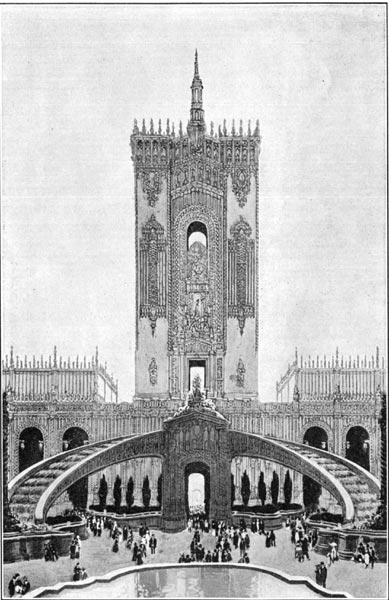 Tower and Cascade, Court of Abundance Here will assemble many of the facinating pageants that will come from the concession center to draw visitors to the amusement features or Midway of the Exposition. Copyright 1913 by the P.P.I.E. Co. |
|||||||||||||||||||||||||||||||||||||||||||||||||||||||||||||||||||||||||||||||||||||||||||||||||||||||||||||||||||||||||||||||||||||||||||||||||||||||||||||||||||||||||||||||||||||||
 California Building This will be in the Old Mission Style. It will cover approximately 365 x 365 feet, will be two stories in height and its construction and furnishings will represent an outlay of $500,000. The building will be provided with a grand ball room 54 x 126 feet. One hundred thousand feet of display space is provided for. Copyright 1913 by the P.P.I.E. Co. |
|||||||||||||||||||||||||||||||||||||||||||||||||||||||||||||||||||||||||||||||||||||||||||||||||||||||||||||||||||||||||||||||||||||||||||||||||||||||||||||||||||||||||||||||||||||||
| Near San Francisco. - A week of side trips should be planned to points adjacent to the metropolis of the West. Oakland, Alameda, and Berkeley beckon over a thirty-minute ride, while the University of California, Stanford University, Mare Island Navy Yard, Mt. Tamalpais, Muir Woods, Piedmont Springs, the fertile Santa Clara Valley, wooded and beautiful Marin County, and many other attractive jaunts will add to the visit's pleasure and to the pleasant memories that will always be associated with the journey to San Francisco. After completing your stay at San Francisco, there are dozens of seaside and mountain resorts, spas, etc., throughout the Pacific Coast that can be visited with pleasure and profit. Among those that will be of especial interest are points in the Great Central Sacramento and San Joaquin Valleys, the Oil Fields, the Mining Districts, various Groves of Big Trees, Mt. Shasta, Lake Tahoe, the Yosemite Valley, Lake County, Santa Cruz, Del Monte, Paso Robles, Santa Barbara, Los Angeles and surroundings, Alaska, and the Great Northwest. Automobiling. - The motorist, in 1915, will be able to reach all points on the Pacific Coast over smooth county and state highways. The enormous sum of $18,000,000 has been appropriated by the state for the construction of two state highways to traverse its length from north to south, one through the interior valleys and the other along the coast. Welcome. - To this Panama-Pacific International Exposition - fit in its manifold marvels to celebrate man's crowning achievement over Nature's most stubborn and malignant forces - San Francisco bids the world. The welcome is not the timorous invitation of a debutante in the world's experience, nor boastful like an impulsive youth's; it is confident and hearty, for its security rests in the attainments of a past that is rich in romance-with its Spanish Portolas, its English Drakes, its siestas of early years. San Francisco is bold with the heritage of pioneer builders, hardy frontiersmen and their wonderful women. She is calm with recent triumphs over a disaster that staggered the world with its fiery magnitude, and is optimistic with hope grounded deep in a history wherein is seen that all things have, indeed, worked together for good. In such a spirit does San Francisco offer the world a Western welcome. |
|||||||||||||||||||||||||||||||||||||||||||||||||||||||||||||||||||||||||||||||||||||||||||||||||||||||||||||||||||||||||||||||||||||||||||||||||||||||||||||||||||||||||||||||||||||||
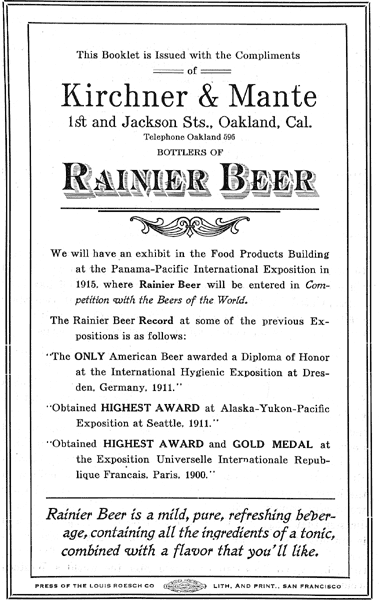 |
|||||||||||||||||||||||||||||||||||||||||||||||||||||||||||||||||||||||||||||||||||||||||||||||||||||||||||||||||||||||||||||||||||||||||||||||||||||||||||||||||||||||||||||||||||||||
|
This Booklet is Issued with the Compliments of
Kirchner & Mante 1st and Jackson Sts., Oakland, Cal. Telephone Oakland 596 Bottlers Of Rainier Beer We will have an exhibit in the Food Products Building at the Panama-Pacific International Exposition in 1915. where Rainier Beer will be entered in Competition with the Beers of the World. The Rainier Beer Record at some of the previous Expositions is as follows: "The Only American Beer awarded a Diploma of Honor at the International Hygienic Exposition at Dresden. Germany. 1911." "Obtained Highest Award at Alaska-Yukon-Pacific Exposition at Seattle, 1911." "Obtained Highest Award and Gold Medal at the Exposition Universelle Internationale Republique Francais, Paris, 1900," Rainier Beer is a mild, pure, refreshing beverage, containing all the ingredients of a tonic, combined with a flavor that you'll like. Press of the Louis Roesch Co. Lith. and Print., San Francisco |
|||||||||||||||||||||||||||||||||||||||||||||||||||||||||||||||||||||||||||||||||||||||||||||||||||||||||||||||||||||||||||||||||||||||||||||||||||||||||||||||||||||||||||||||||||||||
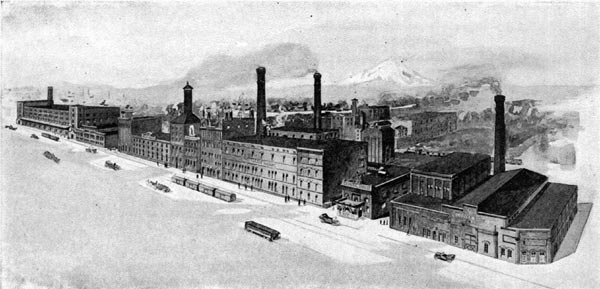 The Home of Rainier Beer Plant of the Seattle Brewing & Malting Co., at Seattle. The Largest Brewery on the Pacific Coast. |
|||||||||||||||||||||||||||||||||||||||||||||||||||||||||||||||||||||||||||||||||||||||||||||||||||||||||||||||||||||||||||||||||||||||||||||||||||||||||||||||||||||||||||||||||||||||
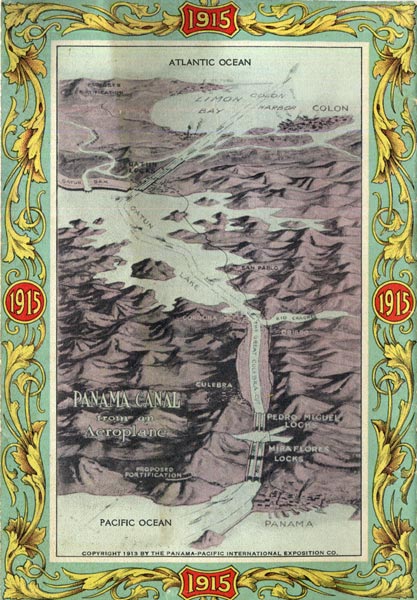 |
|||||||||||||||||||||||||||||||||||||||||||||||||||||||||||||||||||||||||||||||||||||||||||||||||||||||||||||||||||||||||||||||||||||||||||||||||||||||||||||||||||||||||||||||||||||||
|
|
|||||||||||||||||||||||||||||||||||||||||||||||||||||||||||||||||||||||||||||||||||||||||||||||||||||||||||||||||||||||||||||||||||||||||||||||||||||||||||||||||||||||||||||||||||||||